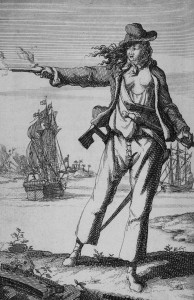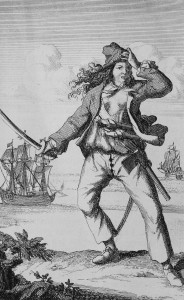As a culture, we love pirates. We love them so much that Disney was able to turn a mediocre theme park ride into a multimillion dollar movie franchise that refuses to die. But what is it that draws us to these sea robbers again and again? Their quest for freedom? Their embrace of death? Their undeniable readiness to use violence against their enemies? Whatever the reason, we return again and again to that image of a pirate captain swaggering the length of his ship and the sailor throwing his lot in with criminals to make a living.
More elusive is the female pirate. It’s not that she didn’t exist. In fact, despite the enduring image of seafaring as a man’s game, women were frequently present on ships during the 17th and 18th centuries, both as passengers and as crewmembers. The former were often wealthy wives and daughters traveling as guests of captains or diplomats. The latter worked everywhere from whaling ships to naval vessels, in various capacities and usually in disguise. Cross-dressing was a common practice for working class women-it was a viable economic option that served as an alternative to unwanted marriages or poverty. When one pretended to be a man, a whole new world of possibilities opened up.
So we know why women became sailors. It’s less clear why some of them might have turned pirate, but we can guess that their motives were fairly similar to those of men: money, adventure, the promise of hot meals and available alcohol. Not to mention the stories. The trope of the woman warrior was all the rage in the 17th and 18th centuries, as were tales of pirates. It’s easy to imagine a poor young woman getting swept up by the idea of adventure and ready money on the waves.
We’ll never be able to know how many women turned pirate, during piracy’s Golden Age (approximately 1650 to 1730) or otherwise. Record keeping was patchy, and the women who did come to light became famous either through folklore or by being caught. But these ladies, thanks to their cunning, theatrics, and invincibility in duels, were a sailor’s worst nightmare.
The Pirate Queens
In the early years of piracy, long before the 17th century, the women who became pirates were often born to privilege, using their wealth on land as a springboard for their conquest of the seas. During this period, piracy was seen less as an affront to the law and more as an acceptable way to expand a ruler’s territory and wealth.
Alfhild
Alfhild was a Danish Goth princess in the mid-5th century CE who took to the seas to escape an unwanted marriage. It’s unclear whether she thought the man unsuitable or if she just wasn’t ready to marry. Nonetheless, piracy seemed like a better option. She first joined a crew of cross-dressing women pirates and later took command of another ship, this one crewed by men. One version of her story reports that she became such a menace to the Danish shipping trade that a young prince named Alf was sent out to stop her, not knowing that she was actually his former betrothed. When he finally caught up to her, he killed most of her crew, and she dramatically revealed her identity by removing her helmet. She was so pleased by his performance in battle that she decided it was worth marrying him after all. It makes sense-a woman who had just spent her time kicking ass and taking names would need a husband who could keep up.
Grace O’Malley
Arguably the most famous of the pirate queens, Grace O’Malley (or Granuaile, as she is usually known in Irish folklore) was the daughter of a tribal leader in 16th century Ireland. She was known to be headstrong and wild, as well as a daring and shrewd tactician and negotiator. Thanks to her upbringing in a tribe known for its seafaring ways, she found it easy to transition from being a power on land to one at sea. Grace was active at a time when piracy along the Irish coast was rampant-it was not an easy world to be a part of, and she excelled at it. She married another clan leader and rose to the position of de facto leader, though after her husband’s death, she was removed from power. Not to be deterred, she used the land and allegiance she had inherited from both her father and her husband to build something of a pirate empire. She taxed and plundered the ships that passed through her waters and eventually rose to command upwards of 200 men. When her brother and sons were captured following a scuffle with the English, Grace traveled to London and negotiated their release with none other than Queen Elizabeth I herself. Perhaps most impressive of all, despite her dangerous and violent life, she died a wealthy old woman in one of her multiple castles. Which, considering that few other pirates-male or otherwise-were able to achieve the same stylish and pleasant exit from life, just goes to show that Grace was a crafty badass of the highest order.
The Women of the Golden Age
Centered around the Caribbean and the Atlantic coast of what would become the United States approximately 50 years later, the Golden Age of Piracy featured some of the best known pirates, including Edward Teach (aka Blackbeard) and Bartholomew “Black Bart” Roberts. This is also the age that produced arguably the two most famous female pirates, Anne Bonny and Mary Read.
Anne Bonny was born in Cork, Ireland as the illegitimate daughter of a lawyer and his maid. This led to a fairly drawn-out scandal. Even though they did not have the likes of a paternity test back in those times, many were convinced that he was the father. Her father failed in his attempts to pass her off as a relative’s child. Eventually, her parents began to live together publicly, and the family moved to Charleston, South Carolina. Anne was a feisty child. There were rumors that she had once attacked a family servant and others that she had beaten up a man who made unwanted advances on her. Never one for the quiet life, Anne ignored her father’s protests and married a poor sailor, following him to the Caribbean. But she quickly grew bored again and, at the first opportunity, ran off with another man, pirate captain “Calico” Jack Rackam. She lived aboard his ship as his lover but also as an incredibly able pirate, and it did not take long for her to garner the crew’s respect in her own right. Anne was fond of theatrics and often orchestrated frightening shows of force that caused enemy ships to surrender without the bother of a battle. When she did fight however, she was ruthless, usually wielding a cutlass, a pistol, or both. It was while she sailed with Calico Jack that Anne befriended another soon-to-be-famous female pirate: Mary Read.
Like her compatriot Anne Bonny, Mary Read was an illegitimate child, born in a suburb of London. Her mother had had an affair while her husband was off at sea and, in order to take advantage of the generosity offered by her mother-in-law, Mary’s mother passed her daughter off as the recently-deceased son she had had with her husband. Mary apparently took a liking to living as a boy, because as soon as she was grown, she enlisted in the British army, still disguised as a man. During that time, she met and fell in love with another soldier, to whom she revealed her true identity. The pair left the army and married, but Mary’s new husband died shortly afterwards. Left without an income, Mary turned to cross-dressing once again and became a sailor on a voyage bound for the West Indies. Along the way, her ship was taken by pirates. Specifically by those pirates captained by Jack Rackam. After a bit of gender confusion and some unnecessary jealousy on Rackam’s part, Read revealed her true gender and became good friends (some say lovers) with Anne Bonny. Like her friend, she was a fearsome fighter and had no time for cowardice. When their ship was on the brink of being captured, she and Anne, as well as one unnamed fellow pirate, were the only crewmembers above decks standing their ground. She was so furious with her fellows that she took a brief break from firing her guns at the enemy and fired into the hold, killing one sailor and wounding at least one other. To Mary, being a coward was to be useless and, if a man was going to be useless, he might as well be dead.
Despite their efforts, though, Anne and Mary were captured along with the rest of Rackam’s crew. When Rackam came to see Anne just before his hanging, she said “she was sorry to see him there, but if he had fought like a Man, he need not have been hang’d like a Dog.” Which probably wasn’t the comfort her lover was looking for. Both women escaped execution by claiming they were pregnant. Mary died in her cell not long after of an unspecified illness and Anne, whose father had apparently decided to forgive her, was freed from jail and disappeared.
Like their predecessors, Anne and Mary were bold and fearsome, operating openly as women and still gaining the respect of their fellow pirates. We don’t know how many others like them there were at the time, how many managed to escape back into a normal life on land, or who died without recognition. Nonetheless, these women, from Alfhild to Mary Read, managed to capture the imagination of their contemporaries, and they continue to do so today.
Sources/Suggestions for Further Reading:
A General History of the Pyrates by Captain Charles Johnson
Bold in Her Breeches: Women Pirates Across the Ages by Jo Stanley
Villains of All Nations: Atlantic Pirates in the Golden Age by Marcus Rediker
Iron Men, Wooden Women: Gender and Seafaring in the Atlantic World, 1700-1920 ed. Margaret S. Creighton & Lisa Norling
Pirates and Buccaneers of the Atlantic Coast by Edward Rowe Snow
Header image via the Smithsonian Magazine. Images of Anne Bonny and Mary Read via Royal Museums Greenwich.




